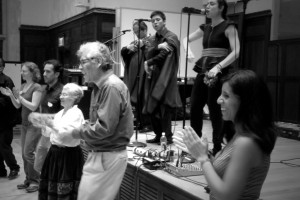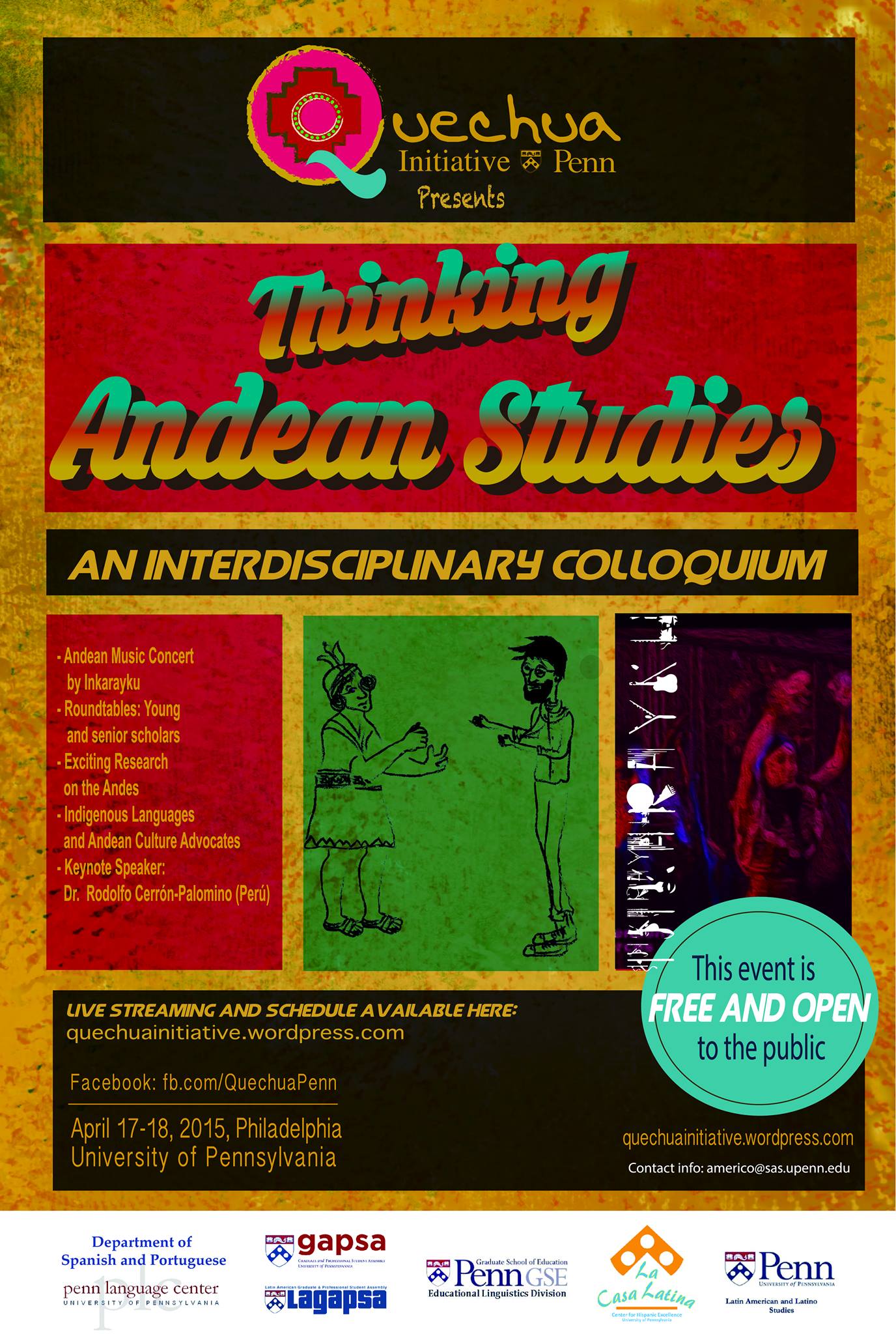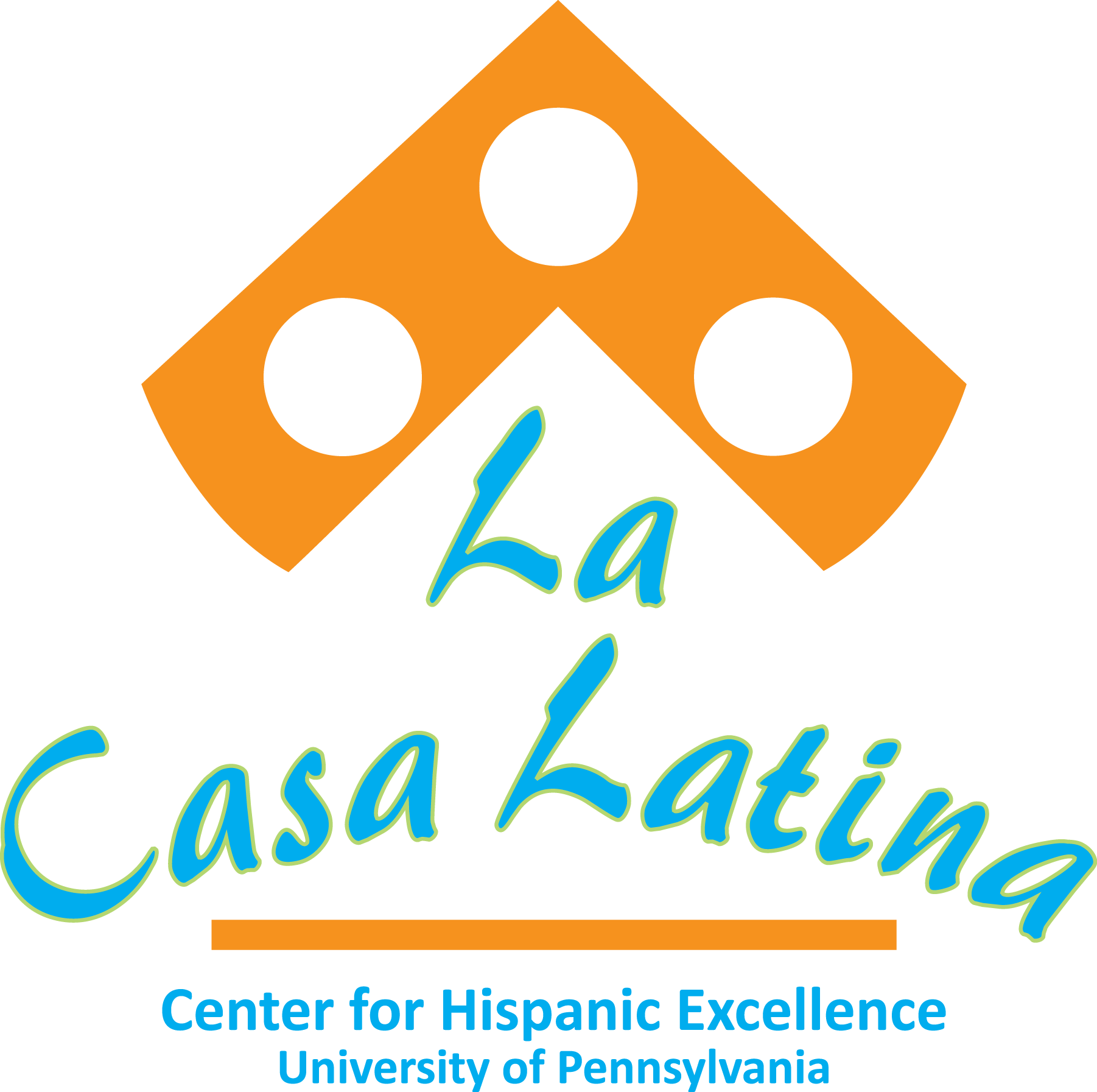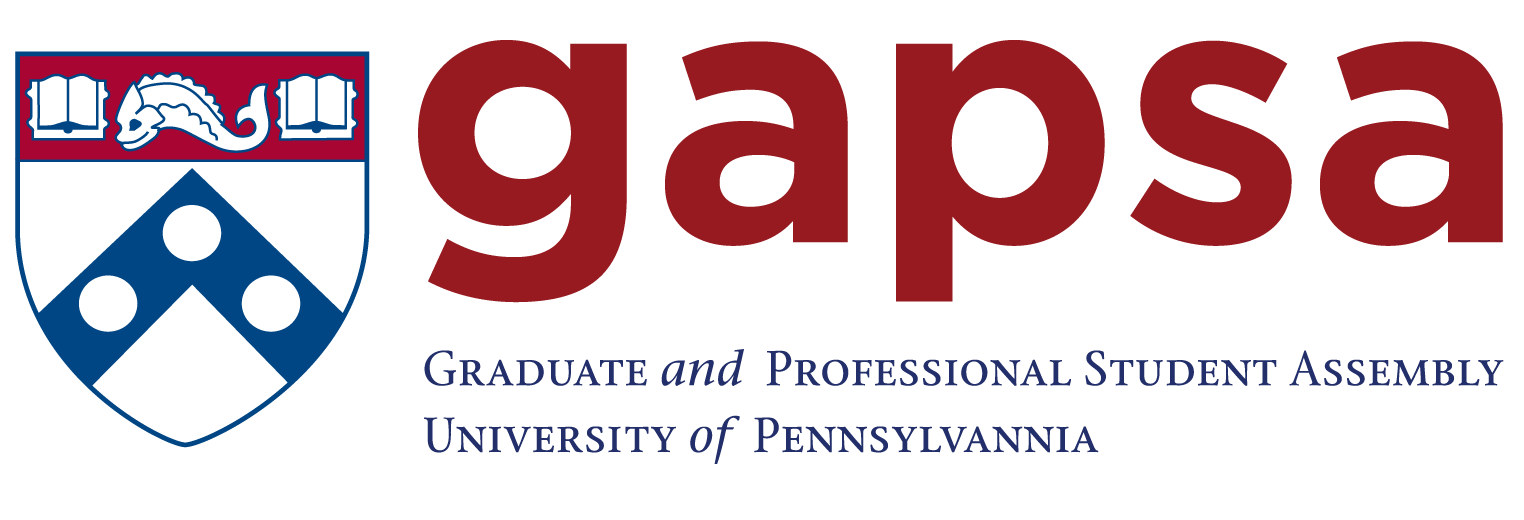First Edition of the “Thinking Andean Studies” (April, 2015)
More event photos: here: http://goo.gl/8o17I5
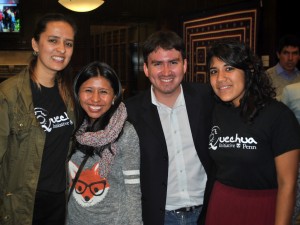
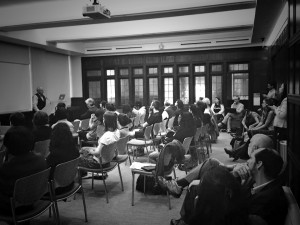
The event featured 25 panel speakers, including professors and graduate students, representing 19 universities, from 3 countries (USA, Peru, Spain). The event was organized by the Quechua Penn Initiative on April 17-18, 2015.
Several disciplines were represented, including: educational linguistics, linguistics, literature, history, anthropology, ethnomusicology, film studies, cultural studies and education. Renowned Quechua researcher and professor Dr. Rodolfo Cerrón-Palomino(PUCP university, Peru) was the keynote speaker.
The event featured a panel of 7 activists and advocates from 4 US states (NY, PA, MA, FL) and from Peru.
A total of 50 attendees joined us throughout the event at Penn. And up to 102 participants joined us via live stream throughout the event.
We thank our sponsors: Spanish and Portuguese Department, Educational Linguistics Division (GSE), Penn Language Center, Latin American and Latino Studies, GAPSA, LAGAPSA and La Casa Latina.
2015 PROGRAM
Thinking Andean Studies: an Interdisciplinary Colloquium
Philadelphia, April 17-18, 2015 University of Pennsylvania
PROGRAM
The event is free and open to the public. Please, RVSP here.
Friday, April 17, 2015
PENN PROFESSORS ROUNDTABLE | 3:00pm – 4:30pm | Arch 109
Nancy Hornberger (Educational Linguistics)
Tamara Walker (History)
Marie Elise Escalante (Romance Languages)
Panel 1: Interdisciplinary perspectives on Indigeneity| 5:00pm – 6:30pm | Arch 109
Marlen Rosas (University of Pennsylvania)
“The Mobilization of Indigenous Peasants: Ideology, Labor, and Schools in Ecuador, 1920s-1940s”
Elkin Pérez Arroyo (University of Missouri)
“Two literature perspectives of Colombia’s Andean Indigenism: Diego Castrillón Arboleda and Manuel Quintín Lame”
Frances Kvietok Dueñas (University of Pennsylvania)
“Suffixes, llamas and Cheese Tris: Language ideologies in a Quechua heritage language class”
OPENING RECEPTION | 7pm – 9:00pm | Arch 208
+ Andean Music Concert with Inkarayku
Saturday, April 18
BREAKFAST | 8:30am – 9:00am | La Casa Latina, Arch G12 (basement)
PARALLEL PANEL SESSIONS I | 9:00am – 10:15am | Arch 107
Panel 2: Representation in Film and Literature 9:00am – 10:20am
Iliana Pagán-Teitelbaum (West Chester University, Pennsylvania)
“Andean Others in Latin American Film”
Danilo León (University of Missouri)
“Andean Immigrants in Spain: Helena Taberna’s Extranjeras and Isabel de Ocampo’s Evelyn”
Julio Noriega (Knox College)
“Cuentos Transatlánticos: La Carta Santa y El Indio Come“
Panel 3: Sounds and Indigenous voices 9:00am – 10:20am | Arch 110
Violet Cavicchi (Brown University)
“We Are Cusqueños: Indigenous Voice in Quechua Radio Music”
Antonia Mardones (Columbia University)
“Ethnic and National tensions on the Chilean appropriation of cumbia music”
PARALLEL PANEL SESSIONS I 10:30am – 11:45am
Panel 4: Building-up discourses in the Andes | Arch 107
Alana Ackerman (University of Illinois at Urbana-Champaign)
“An Anthropology of Ecuadorian Government Discourse: Bolivarian Integration and the Persistence of the ‘other’ “
Leigh Campoamor (Lafayette College)
“Infancia Incorporated: Children’s Rights, Corporate Social Responsibility, and the Promise of Education”
Dina Vera (Quechua Nuestra Lengua)
“Promotion of the traditional knowledge of Quechua using the New Technologies of the information and communication”
Panel 5: Identity, Traditions and Globalization | 10:30am – 11:45 am | Arch 110
Claudia Urdanivia (Hunter College)
“The global quinoa market and implications for local farmers in Puno, Peru”
Caroline Garriott (Duke University)
From the Highlands of Bolivia to Coastal Peru: Crafting Networks of Marianic Devotion
Candy Hurtado (Florida Atlantic University)
“The Subaltern Speaks: Dance as Performative Mimicry in the Central Peruvian Andes, the Case of the Tunantada of Jauja”
LUNCH | 11:50pm – 1:30pm | Casa Latina, Arch G12 (basement)
Andean Language and Cultural Advocates Lunchtime Panel | Arch 110
Living Quechua, with Christine Mladic
Quechua Penn Initiative, with Américo Mendoza-Mori
Kichwa Hatari, with Charlie Uruchima
Kuyayky Foundation, with Candy Hurtado
Quechua courses at UMass Amherst, with Carlos Molina-Vital
Indigenous Communicators Network of Peru (REDCIP), with Rosa Palomino.
Runasimi Outreach Committee (NYU), with Natalie Povilonis de Vilchez
INVITED FACULTY PANEL I | 1:40pm – 3:10pm | Arch 107
Serafín Coronel-Molina (Indiana University)
Quechua and Aymara in virtual spaces
Joshua Tucker (Brown University)
The Indigenous Airwaves as Political Space: Quechua Music and Cultural Activism in Highland Peru
Marilyn Manley (Rowan University)
Quechua Honesty in Language and Identity
Ulla Berg (Rutgers University)
Campesinos Cosmopolitas: Race, Migration and New Elites in Andean Peru
INVITED FACULTY PANEL II | 3:10pm – 4:40pm | Arch 110
Elizabeth Monasterios (University of Pittsburgh)
La intervención de Gamaliel Churata en la dinámica descolonizadora andina
Ulises Zevallos (Ohio State University)
Archipiélagos transandinos. Hacia una nueva cartografía de la transformación cultural
Gillian Gallagher (New York University)
Phonotactics in the Synchronic Grammar of Cochabamba Quechua
Thomas Abercrombie (NYU)
Aymara Prophets in 17th-Century Charcas (Peru), and their 21st-Century Descendants
KEYNOTE: Rodolfo Cerrón-Palomino | 5:00pm – 6:15pm | Houston Hall 218-Ben Franklin
Language as a Hermeneutic for Understanding the Past: On Puquina Language in the Creation of the Inca Empire
CLOSING RECEPTION | 6:15pm – 8:00pm | Houston Hall 218-Ben Franklin
———–
FACULTY PANEL ABSTRACTS
I (Friday 1:30pm – 3:00pm)
Serafín Coronel-Molina (Indiana University)
TBA
Joshua Tucker (Brown University)
The Indigenous Airwaves as Political Space: Quechua Music and Cultural Activism in Highland Peru
Peru lacks an indigenous political movement like those of its Latin American peers, often leading scholars to describe the country as exceptional or politically aberrant. However, scholars like María Elena García, Ramón Pajuelo, and Marisol de la Cadena have challenged the consensus view by looking away from the state and toward the local politics of self-determination, asking whether dominant analytical frames misrecognize the claims to resources, language, education, and cultural survival that indeed move peoples of the Andes.
has led to conflict with younger musicians who stray from the traditionalist line of the station itself. Thus my account nuances existing accounts of Andean cultural agency, by asking how political claims are reframed as they scale up from local-level efforts to spaces where they necessarily engage new voices.
Quechua Honesty in Language and Identity
Unlike Spanish, Cuzco Quechua makes use of three enclitics (–mi/-n, -chá and –si/-s) and two past tense morphemes (-r(q)a- and –sqa-) which communicate evidentiality (information source), epistemology (degree of certainty/doubt) and, in the case of –sqa-, mirativity (surprise or newsworthiness) (Manley, forthcoming). Other Quechua language varieties include similar grammatical expressions. Speakers who use these morphemes qualify the message content they pass on, thereby providing additional information to the hearer that may be used to judge truth-value. It is argued here that messages conveyed with these grammatical expression s may be considered to encode a higher degree of honesty than those without this type of qualification and, as such, may contribute to Quechua speakers’ view of themselves as honest people. In addition to the claim that these grammatical expressions help to shape Quechua speakers’ identity and worldview, it is also put forth here that the well-known Inca moral code, Ama qhella, ama llulla, ama suwa (‘Don’t be lazy, don’t lie, don’t steal’), has a similar impact on Quechua speakers’ worldview and identity formation.
In general, as it is claimed here that linguistic structure influences speakers’ thought, this work follows the principle of linguistic relativity. According to Casasanto (2008:69), such research, investigating the influence of language on thought, has experienced a renaissance. This work intends to add to the body of literature that explores the connection of language and thought, including in terms of speakers’ worldview and identity.
Ulla Berg (Rutgers University)
Campesinos Cosmopolitas: Race, Migration and New Elites in Andean Peru
This paper examines the social and cultural significance of the rise of new elites in Peru as embodied in the much-touted figure of the “entrepreneurial cholo.” Celebrated by foreign investors and neoliberal ideologues but oftentimes feared by old-money elites, the figure of the successful entrepreneurial cholo inhabits an ambiguous position in contemporary Peruvian society. Despite their significant contribution to Peru’s economic growth and their unprecedented access to economic capital, these nuevo rico Peruvians of Andean background are not exempt from racism and adverse forms of discrimination within Peruvian society. Drawing on long-term ethnographic fieldwork on migration and racialization within Peru and beyond its borders and on preliminary fieldwork on new elites in Lima and in the highland city of Huancayo, this paper seeks to map out the rise of these new “cholo elites,” their aspirational projects, and the challenges they face when trying to claim elite status—often articulated through complex transnational networks and alliances. In doing so, this paper—and the larger project it articulates—examines in a preliminary way the historically shifting meanings and manifestations of “elites” and of “privilege” in Peru as well as the intersection of race with the distribution of economic, social, emotive, cultural, political, and knowledge capitals in the changing character of Peruvian inequality.
Panel II (Friday 3:00pm – 4:30pm)
Elizabeth Monasterios (University of Pittsburgh)
La intervención de Gamaliel Churata en la dinámica descolonizadora andina
TBA
Ulises Zevallos (Ohio State)
Archipiélagos transandinos. Hacia una nueva cartografía de la transformación cultural
Los prefijos trans, inter o la pluralización de ciertos términos son cada vez más frecuentes en diversos campos de estudios. En esfuerzos inclusivos y expansivos, se enfatizan los movimientos, las conexiones y relaciones entre unidades que antes se consideraban discretas. Entre ellas se habla con más insistencia sobre los estudios transandinos. En este artículo voy a llevar a cabo un rastreo de los modelos teóricos y sus aplicaciones prácticas que se han venido desarrollando en el campo de los estudios andinos en los últimos 25 años. Considero que es necesario hacer una genealogía de los estudios transandinos para ver sus aportes y quizás limitaciones. En este esfuerzo genealógico, no quiero negar los desplazamientos y la existencia de relaciones y conexiones que se relievan sino quiero seguir abogando por las especificidades andinas que siguen dando sentido a muchas de nuestras carreras.
Gillian Gallagher (NYU)
Phonotactics in the Synchronic Grammar of Cochabamba Quechua
In Bolivian Quechua, sounds known as ‘ejectives’ [p’ t’ t’ k’ q’] and ‘aspirates’ [ph th th kh qh] are found alongside the plain stops [p t t k q] found in other Quechua varieties, leading to contrasts such as [t’anta] ‘bread’, [thanta] ‘rag’, [tanta] ‘to gather’. In this talk, I’ll give an overview of the heavily restricted distribution of ejectives and aspirates in Bolivian Quechua, e.g., there are roots with initial ejectives ([t’uru] ‘mud’) and roots with medial ejectives ([rit’i] ‘snow’), but there are no roots with two ejectives *[t’ut’i]. I’ll also present the results of a series of experiments with Bolivian Quechua speakers testing their implicit knowledge of these restrictions.
Thomas Abercrombie (NYU)
Aymara Prophets in 17th-Century Charcas (Peru), and their 21st-Century Descendants
Drawing on a pair of trial records from Oruro, Peru dating from 1680, the paper treats two unusual cofradías organized by indigenous purchasers of small images of the Virgin (retablos) after visiting miraculous pilgrimage shrines. The documents, each titled Proceso de Jilsa, treat a kind of cofradía leader that secular judges labeled embustero (con-man), but indigenous followers called jilsa, literally “our elder brother,” but glossed by witnesses as “prophet”. Founding chapels and leading highly unorthodox devotions, the jilsas led followers through lengthy prayer sessions, including penitential scourging, that led to mystical states. Testimony depicts what followed: direct intercession via the descent of the holy spirit, ventriloquized possession of the jilsas by heavenly beings, and their conversion into living oracles through which their followers could consult those beings to answer their questions about about the status of their interests in this and other worlds. Finding comparable acts in the devotions of Santa Rosa de Lima, the paper also compares such 17th-C practices to 21st century shamanic activities, in which Aymara ch’iar yatiri, “knowers of darkness” invoke mountains and condors, in the context of living pilgrimage shrines in the Andean region.
This event was sponsored with the generous support of:
